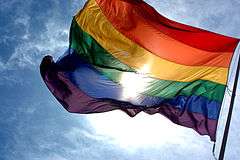Gay lisp
The gay lisp is a stereotypical manner of speech associated with gay males, particularly in English-speaking countries, that involves their pronunciation of sibilant consonants and sometimes other verbal features.[1][2]
These attributes have proven difficult to define and quantify but seem somewhat independent of other variables in the phonology of the English language, such as accent and register. While not all gay males speak with the "gay lisp,"[3] other studies have found when people listened to audio recordings of male speakers and were asked to identify their sexual orientation, their guesses were accurate at rates greater than chance.[4] Two studies did find that a subset of gay men phonate /s/ distinctively; however, the way in which /s/ was pronounced—with a high peak frequency and a highly negatively skewed spectrum—made it more distinctive from other similar sounds, rather than less. That is, this was arguably a hypercorrect /s/.[5][6]
Characteristics
Several speech features are stereotyped as markers of gay males: careful pronunciation, wide pitch range, high and rapidly changing pitch, breathy tone, lengthened fricative sounds, and pronunciation of /t/ as /ts/ and /d/ as /dz/ (affrication).[1]
The "gay sound" of some gay men seems to some listeners to involve the characteristic "lisp" involving sibilants (/s/, /z/, /ʃ/, and the like) with assibilation, sibilation, hissing, or stridency.[1]
Henry Rogers and Ron Smyth, professors at the University of Toronto, investigated this.
According to Rogers, people can usually differentiate gay- and straight-sounding voices based on certain phonetic patterns. "We have identified a number of phonetic characteristics that seem to make a man’s voice sound gay," says Rogers. "We want to know how men acquire this way of speaking."[7]
A study at Stanford University involving a small sample group investigated claims that people can identify gay males by their speech and that these listeners use pitch range and fluctuation in deciding.[8] Results were inconclusive:
Although he found that listeners could distinguish gay from straight men, he failed to find any convincing empirical differences in pitch between these two groups. [...] This study is representative of others that have failed to find concrete differences in the speech of gay and straight men.[9]
In a similar study of female speakers, it was found that listeners could not tell lesbian speakers from heterosexual speakers. Other studies of lesbian identity do make references to voice use by lesbians typically using lower pitch and more direct communication styles.[10]
See also
References
- 1 2 3 Bowen, Caroline (2002). "Beyond Lisping: Code Switching and Gay Speech Styles". Retrieved January 19, 2011.
- ↑ McKinstry, Oliver (March 1, 2002). "Queering Multiculturalism". The Mac Weekly. Macalester College. Archived from the original on September 22, 2006. Retrieved January 19, 2011.
- ↑ Munson, B., & Zimmerman, L.J. (2006b). Perceptual Bias and the Myth of the 'Gay Lisp'
- ↑ Gaudio, Rudolph (1994) "Sounding Gay: Pitch Properties in the Speech of Gay and Straight Men." American Speech 69: 30-57. Poster Presentation at the Annual Meeting of the American Speech-Language-Hearing Association, Miami, FL.
- ↑ Linville, S. (1998). Acoustic correlates of perceived versus actual sexual orientation in men's speech. Pholia Phoniatrica et Logopaedica, 50, 35-48.
- ↑ Munson, B., McDonald, E.C., & DeBoe, N.L., & White, A.R. (2006). The acoustic and perceptual bases of judgments of women and men's sexual orientation from read speech. Journal of Phonetics.
- ↑ Rynor, Micah (February 18, 2002). "Researchers examine patterns in gay speech". News@UofT. University of Toronto. Archived from the original on November 1, 2007. Retrieved January 19, 2011.
- ↑ Gaudio, Rudolph (1994) "Sounding Gay: Pitch Properties in the Speech of Gay and Straight Men." American Speech 69: 30-57.
- ↑ "Gayspeak". glbtq: an encyclopedia of gay, lesbian, bisexual, transgender, & queer culture. glbtq, inc. 2004. Retrieved January 19, 2011.
- ↑ Atkins, Dawn (1998) "Looking Queer: Body Image and Identity in Lesbian, Bisexual, Gay, and Transgender Communities"
Further reading
- Crocker, L., & Munson, B. (2006). Speech Characteristics of Gender-Nonconforming Boys. Oral Presentation given at the Conference on New Ways of Analyzing Variation in Language, Columbus, OH.
- Mack, S., & Munson, B. (2008). Implicit Processing, Social Stereotypes, and the 'Gay Lisp'. Oral presentation given at the annual meeting of the Linguistic Society of America, Chicago, IL.
- Munson, B., & Zimmerman, L.J. (2006a). The Perception of Sexual Orientation, Masculinity, and Femininity in Formant-Resynthesized Speech. Oral Presentation given at the Conference on New Ways of Analyzing Variation in Language, Columbus, OH.
External links
- Encyclopedia article on "gay speak"
- Economist article on sounding gay
- Beyond Lisping: Code Switching and Gay Speech Styles
- Male voices and perceived sexual orientation: An experimental and theoretical approach
